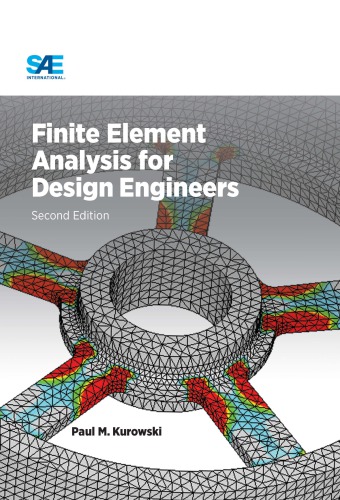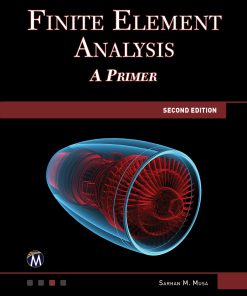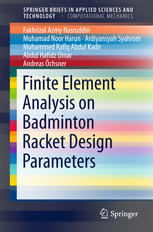Finite Element Analysis for Design Engineers 2nd Edition by Pawel M Kurowski ISBN 0768083699 9780768083699
$50.00 Original price was: $50.00.$25.00Current price is: $25.00.
Finite Element Analysis for Design Engineers 2nd Edition by Pawel M Kurowski – Ebook PDF Instant Download/Delivery: 0768083699, 9780768083699
Full download Finite Element Analysis for Design Engineers 2nd Edition after payment

Product details:
ISBN 10: 0768083699
ISBN 13: 9780768083699
Author: Pawel M Kurowski
Finite Element Analysis (FEA) has been widely implemented by the automotive industry as a productivity tool for design engineers to reduce both development time and cost. This essential work serves as a guide for FEA as a design tool and addresses the specific needs of design engineers to improve productivity. It provides a clear presentation that will help practitioners to avoid mistakes. Easy to use examples of FEA fundamentals are clearly presented that can be simply applied during the product development process. The FEA process is fully explored in this fundamental and practical approach that includes:
- Understanding FEA basics
- Commonly used modeling techniques
- Application of FEA in the design process
- Fundamental errors and their effect on the quality of results
- Hands-on simple and informative exercises
This indispensable guide provides design engineers with proven methods to analyze their own work while it is still in the form of easily modifiable CAD models. Simple and informative exercises provide examples for improving the process to deliver quick turnaround times and prompt implementation.
Finite Element Analysis for Design Engineers 2nd Table of contents:
-
Chapter 1: Introduction to Finite Element Analysis
- What is Finite Element Analysis?
- History and evolution of FEA.
- Applications of FEA in design engineering.
- Overview of the FEA process.
-
Chapter 2: The Basics of FEA
- Key concepts in FEA: Discretization, nodes, elements, degrees of freedom.
- Types of elements: 1D, 2D, and 3D elements.
- Introduction to the stiffness matrix and finite element formulation.
- Understanding boundary conditions and loading.
-
Chapter 3: Mathematical Foundations of FEA
- Basic principles of solid mechanics.
- The method of weighted residuals.
- Governing equations and boundary value problems.
- Numerical methods: Matrix equations and linear algebra.
-
Chapter 4: Types of Finite Elements
- Overview of linear and quadratic elements.
- Beam, plate, shell, and solid elements.
- Special elements: Axisymmetric and 3D elements.
- Element formulations and selection criteria.
-
Chapter 5: Preprocessing for FEA
- Geometry creation and meshing.
- Types of meshing techniques and best practices.
- Refining the mesh and mesh quality considerations.
- Defining material properties and boundary conditions.
-
Chapter 6: Solving FEA Problems
- Direct vs. iterative solvers.
- Solving linear and nonlinear problems.
- Solution techniques for static and dynamic analysis.
- Convergence criteria and error analysis.
-
Chapter 7: Postprocessing and Interpretation of Results
- Visualizing FEA results: Displacement, stress, strain, and temperature distributions.
- Interpreting results for design decisions.
- Identifying errors or problems in the solution.
- Contouring, path plots, and other graphical results.
-
Chapter 8: Linear Static Analysis
- Fundamental concepts of linear static analysis.
- Structural analysis: Stresses, strains, and displacements.
- Common applications in structural design.
- Case studies and practical examples.
-
Chapter 9: Dynamic Analysis
- Introduction to dynamic analysis: Vibrations and transient analysis.
- Modal analysis and natural frequencies.
- Time-domain and frequency-domain analysis.
- Shock, impact, and harmonic analysis.
-
Chapter 10: Nonlinear Analysis
- Understanding nonlinear material behavior: Plasticity, hyperelasticity, and creep.
- Nonlinear geometric behavior: Large deformations and buckling.
- Numerical techniques for nonlinear problems.
- Practical considerations in nonlinear FEA.
-
Chapter 11: Thermal Analysis
- Introduction to heat transfer analysis.
- Steady-state and transient thermal analysis.
- Thermal boundary conditions and material properties.
- Coupling thermal and mechanical analysis.
-
Chapter 12: Fatigue and Fracture Analysis
- Basics of fatigue analysis: S-N curves, damage accumulation.
- Stress-life and strain-life approaches.
- Fracture mechanics and crack propagation.
- Tools for fatigue and fracture analysis in FEA.
-
Chapter 13: Advanced Topics in FEA
- Contact analysis: Contact models and friction.
- Coupled field analysis (e.g., thermo-mechanical analysis).
- Fluid-structure interaction (FSI).
- Multiphysics analysis and challenges.
-
Chapter 14: Design Optimization with FEA
- Introduction to design optimization techniques.
- Topology, shape, and size optimization.
- Sensitivity analysis and optimization algorithms.
- Practical applications in product design.
-
Chapter 15: FEA Software and Tools
- Overview of popular FEA software (ANSYS, ABAQUS, COMSOL, etc.).
- Choosing the right software for your analysis.
- Integration of FEA with CAD tools.
- Automation and scripting in FEA.
-
Chapter 16: Practical Applications and Case Studies
- Case study 1: Automotive structural design.
- Case study 2: Aerospace component analysis.
- Case study 3: Mechanical product design and failure analysis.
- Lessons learned from real-world engineering applications.
-
Chapter 17: Challenges in FEA and Best Practices
- Common mistakes and pitfalls in FEA.
- Best practices for meshing, solving, and interpreting results.
- Validation and verification of FEA models.
- Ensuring accuracy and reliability in FEA simulations.
-
Chapter 18: The Future of FEA in Engineering Design
- Emerging trends in FEA: AI, machine learning, and automation.
- The integration of FEA with IoT and digital twins.
- The evolution of simulation-driven design.
- Future challenges and opportunities in FEA.
People also search for Finite Element Analysis for Design Engineers 2nd:
finite element analysis for design engineers
finite element analysis for design engineers pdf
finite element analysis for design engineers third edition
finite element analysis for design engineers second edition
what is finite element analysis in engineering
Tags:
Pawel M Kurowski,Finite Element,Analysis,Design Engineers
You may also like…
Engineering - Engineering - General & Miscellaneous
Finite Element Analysis A Primer 2nd Edition by Sarhan Musa 1683924169 9781683924166
Mathematics - Applied Mathematics
Extended finite element and meshfree methods Timon Rabczuk 0128141077 9780128141076
Engineering - Engineering Technology
Uncategorized
Science (General)











